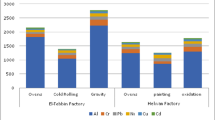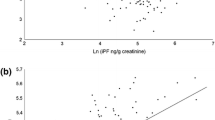Abstract
Occupational exposure to antimony has gained much interest when specific toxic effects were noticed among workers processing antimony. Thus, the aim of the present work was to investigate the potential DNA oxidative damage occurring among Egyptian workers occupationally exposed to antimony trioxide. The study was conducted on 25 subjects exposed to antimony trioxide while working in the polymerization process of polyester in Misrayon and Polyester Fiber Company, KafrEldawwar, Beheira, Egypt. Urinary antimony levels were assessed using inductive coupled plasma–optical emission spectrometry (ICP-OES) and considered as a biological exposure index. DNA damage and total oxidant capacity (TOC) were assessed using ELISA. DNA damage was detected in the form of increased apurinic/apyrimidinic (AP) sites among antimony trioxide-exposed workers compared to control subjects, but it could not be explained by oxidative mechanisms due to lack of significant correlation between DNA damage and measured TOC. Antimony trioxide might have a genotoxic impact on occupationally exposed workers which could not be attributed to oxidative stress in the studied cases.



Similar content being viewed by others
References
Abd-Elmaaboud RM, Mohamed ZT, George SM, Ez El-Dine AM, Shehaby DM (2016) Lead and cadmium toxicity in tile manufacturing workers in Assiut, Egypt. AJFSFM 1(3):6–16
Abhaya N, Kumar R, Dwivedi S (2008) A simple index of smoking. COBRA 40:1–20
Amarasiriwardena D, Wu F (2011) Antimony: emerging toxic contaminant in the environment. Microchem J 97:1–3
Beyersmann D, Hartwig A (2008) Carcinogenic metal compounds: recent insight into molecular and cellular mechanisms. Arch Toxicol 82:493–512
Bocca B, Pino A, Alimonti A et al (2014) Toxic metals contained in cosmetics: a status report. ISRTP 68:447–467
Boreiko CJ (2016) NTP draft report 2-year inhalation carcinogenicity studies antimony trioxide in rat and mice. International Antimony Association Brussels, Belgium: Feb 2016 (unpublished). Available from: https://ntp.niehs.nih.gov/ntp/about_ntp/trpanel/2016/february/publiccomm
Cady NC, Stelick S, Batt CA (2003) Nucleic acid purification using microfabricated silicon structures. Biosens Bioelectron 19:59–66
Cavallo D, Iavicoli A, Setini A et al (2002) Genotoxic risk and oxidative DNA damage in workers exposed to antimony trioxide. Environ Mol Mutagen 40:184–149
Croteau DL, Bohr VA (1997) Repair of oxidative damage to nuclear and mitochondrial DNA in mammalian cells. J Biol Chem 272:25409–25412
Danish Environmental Protection Agency (2015) Available from: http://orbit.dtu.dk/files/117988966/Antimony_MST_2015.pdf
De-Perio MA, Durgam S, Caldwell KL et al (2010) A health hazard evaluation of antimony exposure in fire fighter. J Occup Environ Med 52(1):81–84
European risk assessment report (EU-RAR) (2008) Available from: https://www.echa.europa.eu/documents/trd_rar_sweden_diantimony_trioxide_en.rtf
Filella M, Belzile N, Chen Y (2013) Human exposure to antimony III, contents in some human excreted biofluids (urine, milk, saliva). Crit Rev Env Sci Tec 43(2):162–214
García-Lestón J, Roma-Torres J, Vilares M et al (2012) Genotoxic effects of occupational exposure to lead and influence of polymorphisms in genes involved in lead toxicokinetics and in DNA repair. Environ Int 43:29–36
Gebel T (1997) Arsenic and antimony: comparative approach on mechanistic toxicology. CBI 107:131–144
Grosskopf C, Schwerdtle T, Mullenders L et al (2010) Antimony impairs nucleotide excision repair: XPA and XPE as potential molecular targets. Chem Res Toxicol 23:27
Grover P, Rekhadevi P, Danadevi K et al (2010) Genotoxicity evaluation in workers occupationally exposed to lead. Int J Hyg Environ Health 213:99–106
Hashemzaei M, Pourahmad J, Safaeinejad F et al (2015) Antimony induces oxidative stress and cell death in normal hepatocytes. Toxicol Environ Chem 97(2):256–265
Heitland P, Koster HD (2006) Biomonitoring of 30 trace elements in urine of children and adults by ICP-MS. Clin Chim Acta 365:310–318
Huang Y, Ni W, Chen Y et al (2015) Levels and risk factors of antimony contamination in human hair from an electronic waste recycling area, Guiyu, China. Environ Sci Pollut 22(9):112–119
Jiang X, An Z, Lu C et al (2016) The protective role of Nrf 2-Gadd 45b against antimony-induced oxidative stress and apoptosis in HEK293 cells. Toxicol Lett 5:16
Kirkland D, Whitwell J, Deyo J et al (2007) Failure of antimony trioxide to induce micronuclei or chromosomal aberrations in rat bone-marrow after sub-chronic oral dosing. Mut Res 627:119–128
Lech T (2013) Application of ICP-OES to the determination of barium in blood and urine in clinical and forensic analysis. JAT 37(4):222–226
Liu B, Wu F, Li X et al (2011) Arsenic, antimony and bismuth in human hair from potentially exposed individuals in the vicinity of antimony mines in southwest China. Microchem J 97:20–24
Losler S, Schlief S, Kneifel C et al (2009) Antimony-trioxide-and arsenic-trioxide-induced apoptosis in myelogenic and lymphatic cell lines, recruitment of caspases, and loss of mitochondrial membrane potential are enhanced by modulators of the cellular glutathione redox system. Ann Hematol 88:1047–1058
McCallum RI (2005) Occupational exposure to antimony compounds. J Environ Monit 7:1245–1250
Mann K, Davison K, Colombo M et al (2006) Antimony trioxide-induced apoptosis is dependent on SEK1/JNK signaling. Toxicol Lett 160:158–170
Martin WA, Lee LS, Schwab P (2013) Antimony migration trends from a small arms firing range compared to lead, copper, and zinc. Sci Total Environ 1:463–464
Mir F, Lee D, Ray H, Sadiq SA (2014) CSF isoprostane levels are a biomarker of oxidative stress in multiple sclerosis. Neurol Neuroimmunol Neuroinflamm 1:21
Morales M, Derbes R, Ade C et al (2016) Heavy metal exposure influences double strand break DNA repair outcomes. PLoS 11(3):15–17
Pacheco P, Gil R, Martinez L et al (2007) A fully automated system for inorganic antimony preconcentration and speciation in urine. Anal Chim Acta 603:1–7
Phillips MA, Cánovas A, Wu P, Islas-Trejo A et al (2016) Parallel responses of human epidermal keratinocytes to inorganic SbIII and AsIII. Environ Chem 13(6):963–970
Soares J, Cortinhas A, Bento T et al (2014) Aging and DNA damage in humans: a meta-analysis study. Aging 6(6):432–439
Seiple L, Cardellina J, Akee R et al (2007) Potent inhibition of human apurinic/apyrimidinic endonuclease1 by arylstibonic acids. Mol Pharm Aspet 73(3):670–677
Shtangeeva I, Bali R, Harris A (2011) Bioavailability and toxicity of antimony. J Geochem Explor 110:40–45
Sullivan MJ, Leavey S (2011) Heavy metals in bottled natural spring water. J Environ Health 73(10):8–13
Sundar S, Chakravarty J (2010) Antimony toxicity. Int J Environ Res Public Health 7(12):267–277
Takahashi S, Sato H, Kubota Y et al (2002) Inhibition of DNA double strand break repair by antimony compounds. Toxicology 180:249–256
Watson KD (2001) Antimony in medical history: an account of the medical uses of antimony and its compounds since early times to the present. Med Hist 45(1):141–142
Welle F, Franz R (2011) Migration of antimony from PET bottles into beverages: determination of the activation energy of diffusion and migration modeling compared with literature data. Food Addit Contam 28:115–126
Welna M, Zyrnicki W (2011) Investigation of simultaneous generation of arsenic, bismuth and antimony hydrides using inductively coupled plasma optical emission spectrometry. Anal Lett 44:942–953
Xi J, He H, Wang P (2014) Adsorption of antimony on sediments from typical water systems in China: a comparison of Sb (III) and Sb (V) pattern. Soil Sediment Contam 23:37–48
Yang Y, Yoon S, Hwang Y et al (2012) New titanium-based catalysts for the synthesis of poly (ethylene terephthalate). Korean Chem Soc 33:10
Author information
Authors and Affiliations
Corresponding author
Ethics declarations
The current work was approved by Medical Ethics Committee of Faculty of Medicine, Alexandria University, and a written informed consent was obtained from all subjects before participation in the study.
Conflict of interest
The authors declare that they have no conflict of interest.
Additional information
Responsible editor: Philippe Garrigues
Rights and permissions
About this article
Cite this article
El Shanawany, S., Foda, N., Hashad, D.I. et al. The potential DNA toxic changes among workers exposed to antimony trioxide. Environ Sci Pollut Res 24, 12455–12461 (2017). https://doi.org/10.1007/s11356-017-8805-z
Received:
Accepted:
Published:
Issue Date:
DOI: https://doi.org/10.1007/s11356-017-8805-z




